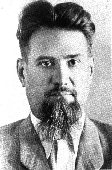 The mature Kurchatov (61 K).
The mature Kurchatov (61 K).




I remember President Kennedy once stated... that the United States had the nuclear missile capacity to wipe out the Soviet Union two times over, while the Soviet Union had enough atomic weapons to wipe out the Unites States only once... When journalists asked me to comment... I said jokingly, "Yes, I know what Kennedy claims, and he's quite right. But I'm not complaining... We're satisfied to be able to finish off the United States first time round. Once is quite enough. What good does it do to annihilate a country twice? We're not a bloodthirsty people." Nikita Khrushchev - quoting himself in Khrushchev Remembers: The last Testament, 1974, pg. 530 |
The most significant early work on fission in the Soviet Union was performed by Yakov Zel'dovich and Yuli Khariton who published a series of papers in 1939-41 that laid the groundwork for later Soviet atomic weapons development.
The Soviet weapons program proper began in 1943 during World War II, under the leadership of physicist Igor Vasilievich Kurchatov. The program was initiated by reports collected by Soviet intelligence about the rapidly growing Manhattan Project in the U.S. It remained largely an intelligence operation until the end of the war, but it was a highly successful one, due to sympathies of many for the wartime Soviet Union fighting Nazi Germany; the socialist political sympathies of some; and the weak security screening program necessitated by the hasty assembly of the vast program. Klaus Fuchs, an important physicist at Los Alamos, was by far the most valuable contributor of atomic information.
 A strikingly handsome picture of Igor Kurchatov as a young man. (18 K)
A strikingly handsome picture of Igor Kurchatov as a young man. (18 K)
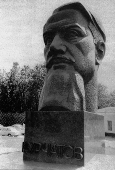 The Kurchatov Monument (78 K)
The Kurchatov Monument (78 K)
Immediately after the conclusion of the war against Japan, the Soviet program moved into high gear. Lavrenti Beria was appointed to head the entire project, with Kurchatov remaining as scientific director. Using the detailed data available on the American program, and the detailed design description of the Fat Man bomb provided by Fuchs in June 1945, the Soviet program achieved its first test in almost exactly four years.
The first Soviet nuclear reactor (and the first nuclear reactor in Europe) went critical on Christmas day 1946, at 6 p.m. local time at the Kurchatov Institute in Moscow. The graphite moderated F-1 (for "Physics-1") was apparently based on the design of the Hanford 305 reactor and originally operated at a power level of 10 watts (later upgraded to 24 kilowatts). Larger graphite moderated plutonium production reactors provided the fissile material for the first Soviet atomic bombs.
| Test: | First Lightning/"Joe-1" |
|---|---|
| Time: | 07:00 29 August 1949 (local) |
| Location: | Semipalatinsk Test Site, Kazakhstan |
| Test Height and Type: | Tower |
| Yield: | 22 Kt |
The first Soviet nuclear test, code named "First Lightning", detonated a plutonium bomb, the RDS-1. The code designation RDS was actually arbitrary and meaningless, but various people on the project gave it a variety of interpretations, one popular one was "Reaktivnyi Dvigatel Stalina" (Stalin's Rocket Engine), another was "Russia Does It Alone". The whole focus of the Soviet program at this point was to set off a Soviet atomic blast at the earliest possible time whatever the cost. At Beria's insistence, this device was an exact copy of the U.S. Gadget/Fat Man design.
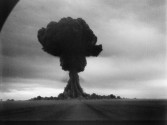 "Joe-1"/First Lightning (640 x 480, 40K)
"Joe-1"/First Lightning (640 x 480, 40K)
This image of the Joe-1 shot was provided by Peter Kuran, director of Trinity and Beyond: The Atomic Bomb Movie (available on video). Footage of this shot can be seen in the movie. Click for a big image of Joe-1 (1024 x 768, 160 K).
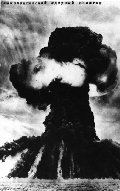
No! This is not a picture of Joe-1! Although two recent books: Stalin and the Bomb: The Soviet Union and Atomic Energy 1939-1956 by David Holloway and Dark Sun by Richard Rhodes contain this image, labelled "Joe-1" they are wrong. This is a picture of a 1965 Soviet test called "Chagan". Thanks to Andy Gillette for pointing this out to me and providing the correct identification.
More than two years passed between the first and second Soviet atomic tests. The crash-program to produce an atomic bomb a quickly as possible had created a very inefficient and hazardous production system, and tremendous effort was required to rationalize the program and place it on a firmer basis.
"Joe-2" was exploded on 24 September 1951 with a yield of 38 Kt. This was an improved plutonium implosion bomb, incorporating some improvements that Beria had prevented from being used in Joe-1.
Although limited theoretical investigations into fusion energy began immediately after the war, the Soviet thermonuclear program shifted into high gear in mid-1948 after accumulating information about American investigations provoked considerable concern. The theoretical investigation was headed by Zel'dovich, who added three important figure to his staff - Andrei Dmitrievich Sakharov, Vitali Lazarevich Ginzburg, and Viktor Aleksandrovich Davidenko.
Like the American program, the Soviet thermonuclear program initially focused on igniting non-equilibrium detonation in liquid deuterium (a scheme eventually shown to be impractical if not impossible). Also like the American program, the idea of amplifying the yield of a fission bomb by igniting a limited fusion reaction in a lithium-6 deuteride blanket also arose. Unlike the American program though, the Soviets actually developed this idea into a deliverable weapon.
This first approach to thermonuclear weapons, called the "Sloika" or "layer cake" (a sloika is a cheap layered pastry somewhat like a napoleon), was originated by Sakharov and Ginzburg. Sakharov contributed the "first idea": the basic idea of heating and compressing a fusion blanket surrounding the fission trigger. Ginzburg subsequently added the "second idea": the improvement of using Li-6 D fuel instead of liquid deuterium and tritium. Sakharov is generally accorded the title of "Father of the Soviet Hydrogen Bomb", a title he began earning by being the lead theoretical designer of the sloika.
 Andrei Sakharov in 1950 (21 K).
Andrei Sakharov in 1950 (21 K).
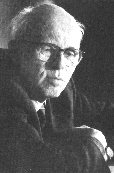 Andrei Sakharov in 1989 (26 K).
Andrei Sakharov in 1989 (26 K).
Click here to see a picture of Vitali Ginzburg (13 K)
| Test: | Test No. 4/"Joe-4" |
|---|---|
| Time: | 12 August 1953 |
| Location: | Semipalatinsk Test Site, Kazakhstan |
| Test Height and Type: | Tower |
| Yield: | 400 Kt |
The detonation of the RDS-6s device, the fifth Soviet nuclear test (dubbed "Joe 4" in the west) demonstrated the use of fusion in a weaponizable design. Not a "true" hydrogen bomb, this device obtained nearly all of its yield from fission and was limited for practical purposes to yields of less than a megaton. It was never widely deployed.
The RDS-6s used a U-235 fissile core surrounded by alternating layers of fusion fuel (lithium-6 deuteride spiked with tritium), and fusion tamper (natural uranium) inside a high explosive implosion system. The small U-235 fission bomb acted as the trigger (about 40 kt). The total yield was 400 Kt, and 15-20% of the energy was released by fusion, and 90% due directly or indirectly to the fusion reaction.
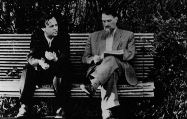 Andrei Sakharov and Igor Kurchatov together (63 K).
Andrei Sakharov and Igor Kurchatov together (63 K).
Efforts to extend the "Sloika" design to higher yields proved infeasible, and following the successful test of Joe-4, the program stagnated. The U.S. had already demonstrated the ability to build a 10 megaton bomb in November 1952 with the Ivy Mike test, but the Soviets had no idea how to duplicate the feat.
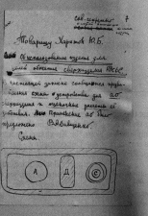
The first conceptual breakthrough came sometime in late 1953. This breakthrough is apparently attributable to Davidenko. Left is a January 1954 sketch by Zel'dovich and Sakharov, addressed to Yuli Khariton, that shows a transitional concept for the hydrogen bomb. The concept shown is equivalent to Stanislaw Ulam's breakthrough of separate staging, using an atomic trigger to compress the thermonuclear secondary. Like Ulam's initial concept, it is based on hydrodynamic compression rather than radiation implosion. Click here for an easier to read photocopy version and translation.
The second breakthrough came in March or April 1954, after the 15 Mt U.S. test of a lithium deuteride fueled hydrogen bomb in Castle Bravo. This second American high yield thermonuclear test stimulated Soviet efforts, and was rewarded with the discovery of radiation implosion. Sakharov worked out the theoretical basis for this process, and is credited with the discovery.
| Test: | Test No. 24/RDS-37 |
|---|---|
| Time: | 22 November 1955 |
| Location: | Semipalatinsk Test Site, Kazakhstan |
| Test Height and Type: | Air drop |
| Yield: | 1.6 Megatons |
This device, designated RDS-37, was the Soviet Union's first test of a two-stage radiation implosion (aka Sakharov's "Third Idea", and Teller-Ulam) design. This was also the world's first air-dropped fusion bomb test (and the 24th Soviet test overall). After this test the Soviet Union used radiation implosion exclusively instead of the Sloika ("Layer Cake") approach.
The bomb's yield was reduced from its design yield for the test by about half by replacing part of the Li-6 D fusion fuel with "a passive material" (probably ordinary lithium hydride). The yield was within 10% of the predicted value.
Air dropped by a crew commanded by F. P. Golovashko (made Hero of the Soviet Union). The bomb exploded underneath an inversion layer, which focused the shock back toward the ground unexpectedly. This refracted shock wave did unanticipated collateral damage, killing three people from a building collapse.
 The Hydrogen ("Super") Test (26 K)
The Hydrogen ("Super") Test (26 K)
| Test: | Chagan |
|---|---|
| Time: | 05:59:59 15 January 1965 (GMT) |
| Location: | Semipalatinsk Test Range, Kazakhstan; Balapan Test Area 49.89 deg N, 78.97 deg E |
| Test Height and Type: | Shaft #1004, -178 m |
| Yield: | 140 Kt |
This was the Soviet Union's first "industrial nuclear explosion", the equivalent of the US "Plowshare" program for developing peaceful nuclear explosives (PNEs). This test was a near copy of the US Sedan test, a 104 Kt subsurface cratering experiment. In the Soviet case, the test was conducted
Although recently misidentified in two books as "Joe-1", this is picture is definitely not the Joe-1/First Lightning test. Joe-1 was a 20 Kt tower shot, and study of the Chagan picture shows copious amounts of debris fallout, a sure-fire indicator of a subsurface explosion. Below is a recent photograph of this same image (reversed) on display at the former test range at Semipalatinsk, Kazakhstan where it is clearly identified as "Chagan" (thanks to Andy Gillette). On display was another image of the actual Joe-1 test (unfortunately unavailable at this time).
 Chagan picture on display at Semipalatinsk (18 K)
`
Chagan picture on display at Semipalatinsk (18 K)
`
The site for the Chagan shot was the dry bed of the Chagan River on the edge of the Semipalatinsk Test Site (STS) in Kazakhstan. The shot location was chosen so that the crater lip would form a dam in the river during its period of high flow in the spring. The crater formed by the Chagan explosion had a diameter of 408 m and a depth of 100 m. A major lake (10,000,000 m 3 ) was quickly formed behind the 20-35 m high upraised lip. Shortly after the explosion, earthmoving equipment was used to cut a channel through the lip so that water from the river could enter the crater.
Spring melt soon filled the crater with 6.4 million m^3 of water, and the reservoir behind the crater was filled with 10 million m^3 of water. These reservoirs are known informally as Lake Chagan or Lake Balapan. Subsidence of the crater slopes subsequently reduced the crater storage capacity by about 25%. A few years later, a water-control structure was built on the left bank of the river to control water levels in the reservoirs. Both reservoirs exist today in substantially the same form and are still used to provide water for cattle in the area. Efrim P. Slavskiy, Minister of the Medium Machine Building Ministry (the ministry responsible for the entire Soviet nuclear weapons program)was reported to have been the first person to have taken a swim in the crater lake.
The nuclear explosive used for the Chagan test was reported to be a low-fission design, which had a pure thermonuclear secondary driven by a fission primary with a yield of about 5-7 kt. Approximately 20% of the radioactive products of the explosion escaped into the atmosphere, resulting in dose levels on the lip of the crater of 20-30 R/hr several days after the explosion, most of which was from Co 60 (5.26 year half-life). Today, the dose level on the lip is reported to be ~2.6 mR/hr. Beyond a restricted area 100-150 m from the lip, the dose rate is at background levels (15-20 microR/hr). Radioactivity levels in the lake water in the crater are reported to be about 300 pCi/liter.
Radioactivity from the Chagan test was detected over Japan by both the U.S. and Japan in apparent violation of the 1963 Limited Test Ban Treaty (LTBT). The U.S. complained to the Soviet Union about the explosion, interpreting it as an accidental venting of a high-yield weapons test and asking for an explanation. The Soviets responded that the explosion was carried out deep underground. The quantity of radioactive debris that leaked into the atmosphere was so insignificant that the possibility of its fallout outside the territorial limits of the Soviet Union should be excluded. After several subsequent interactions, the issue was closed without further explanation.

Sarov, with its monastery and church towers (53 K)
In April 1946, the sleepy town of Sarov with a population of 3000 (best known for its monastery), 400 km east of Moscow, was converted into the super-secret atomic weapons city of Arzamas-16 (sometimes nick-named "Los Arzamas"). For over 45 years Sarov disappeared from the map, to reappear under its original name of Sarov after the collapse of the Soviet Union. Throughout this 45 year period it was headed by one man:Yuli Khariton, Scientific Director of Arzamas-16 from 1946 to 1992.
Below is part of the Arzamas-16 laboratory complex during the forties, the building shown housed the theoretical division.
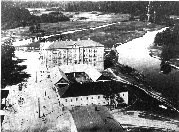 Arzamas-16 laboratory (113 K)
Arzamas-16 laboratory (113 K)
Sarov also hosts the Russian Atomic Weapon Museum, inspired and modelled on the U.S. National Atomic Museum. In the picture below, the weaponized version of Joe-1 can be seen at right and the weaponized version of Joe-4 on left. In the middle is the 40 Kt improved implosion bomb Joe-2.
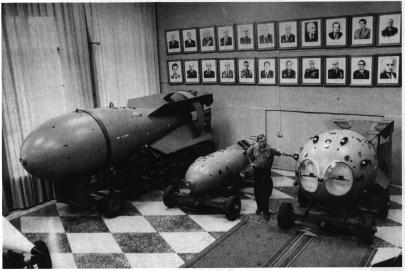 Arzamas-16 Bomb Museum (23 K)
Arzamas-16 Bomb Museum (23 K)
Click here to see a large picture of the museum displays (139 K)
 Khariton with Joe-1 in 1992 (25 K)
Khariton with Joe-1 in 1992 (25 K)